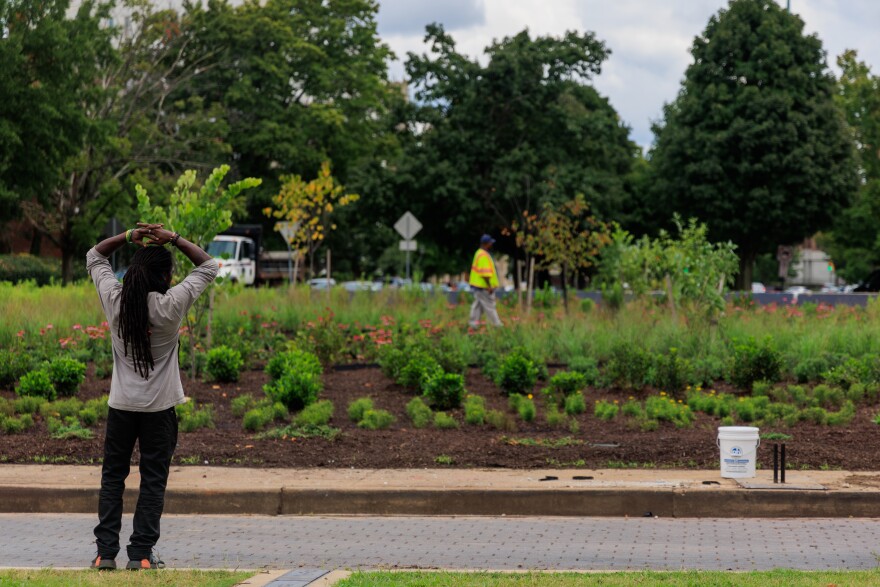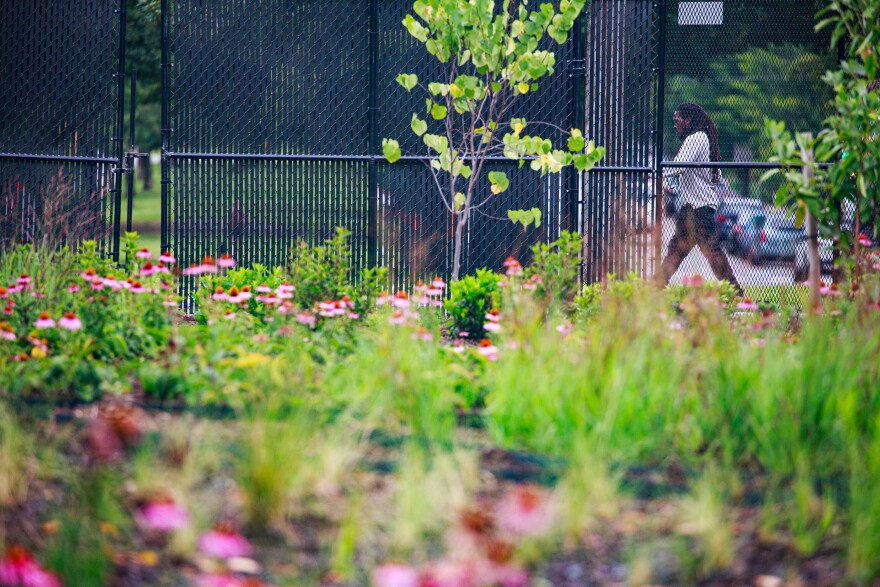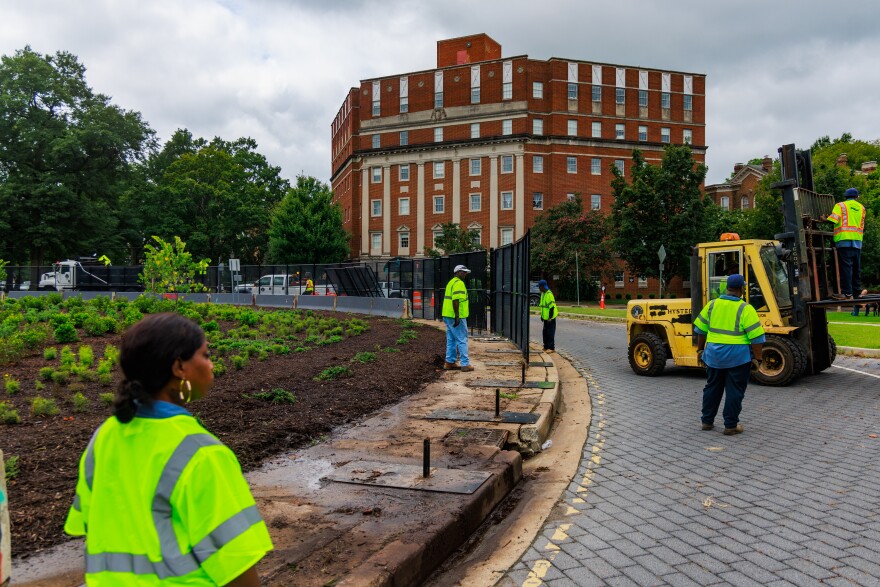Brandon Fountain got his title during the summer of 2020, when the statue of Robert E. Lee on Monument Avenue became an iconic image of protests against police brutality.
The land the bronze figure sat on came to be called Marcus-David Peters Circle by protesters, named for a 24-year-old Black teacher killed by a Richmond police officer in 2018. Fountain, through prior landscaping experience, began caring for a garden in the circle.
“When people started seeing me there every day, that's when they just start calling me ‘The Gardner,’” he said, “and I got the Lord Bumblebee the Gardner name.”
Now, people mostly know him as Bee.
Bee grew food in the garden — and says it taught people patience and resilience in the face of injustice.
“Before we can even get into the biggest scale of like, truly sharing money and equity and property,” he said, “you got to learn how to not pluck things too fast, and let things really grow and take their natural time to develop.”
But in January 2021, the state erected a fence around the circle as it prepared to remove the statue. Lee was removed that September, but the fence remained until August 2023.
People who had come to see it as a gathering space were frustrated and called for the fence to come down as early as January 2021. Bee told a VPM News reporter at the time that the fences interfered with coat and food distribution efforts in the circle.
Bee had to get creative with his garden care, too.
“What I ended up doing when they fenced it off was getting water guns and feeding the plants like that through the fence,” Bee said.
But he couldn’t keep it alive from a distance. It was hard to watch those plants die. But before long, an opportunity arose to start a new garden at the Community Church of God in Christ, just a block away from MDP Circle.
The church welcomed protesters in 2020 and now sports the lush Unity Garden, tended to by Bee and other volunteers.
The space is decked out with all kinds of plants, each one representing a different project Bee is working on — often with others around town. There’s okra growing for a pickler, pinwheels for a local florist, hops to brew non-alcoholic beer and a massive banana plant — a prized possession.
One heart-shaped bed grows beets. As Bee said, “I call them Unity Garden Heart Beets.”
From the circle to Unity Garden, Bee’s gotten help from volunteers along the way. People donate soil, plants and other materials, too.

Meghan Gough, a Virginia Commonwealth University professor who studies civic engagement, planning processes and sustainable development, says Richmond’s public gardens are great examples of taking unused spaces and allowing the community to make something great.
“Food is what’s there, but it’s community that’s really growing in those spaces and what’s driving most of the gardeners,” Gough said.
Gough pointed to Sankofa Community Orchard, operated by nonprofit Happily Natural in Southside, as a prime example — a formerly vacant plot that now boasts rows of crops and colorful murals.
“You can hear it when you talk with people that are there volunteering on a regular basis. People are thinking about ... economic justice and political justice,” Gough said.
Sankofa, like many public gardens in the city, is part of the Richmond Grows Gardens program. The city permits organizations to develop community gardens in un- or underused plots. Eighteen gardens operate through the program, with nine unclaimed sites set aside for others.
In "Advancing Social Equity and Promoting Black Self-determination," Gough’s former student Alessandro Ragazzi wrote that interviews with community garden stewards revealed a range of competing goals and constraints. Gardeners have to make decisions about whether to focus on food production, beautification, political organizing or other goals — while managing the aftereffects of past land uses.
One priority is consistent, Ragazzi wrote: “For all of the stewards and the [Richmond Grows Gardens] Coordinator, cultivating community is critical to the work of a community garden.”
Gough says in order to build more community-driven spaces like the gardens, the city has to listen to what its communities want, instead of deciding for them. She said Richmond has laid good groundwork for that, thanks to equity-focused planning that stressed public engagement before action.
Plans like RVAGreen 2050 Climate Equity Action Plan 2030 recognize that high-quality public spaces are not evenly distributed across town, with a deficit in majority-Black neighborhoods that have historically been passed over for investment. The planning process for that involved engaging with groups of community members in roundtables and interviews.
Richmond City Council passed the RVAGreen2050 earlier this year, laying out the first steps toward a carbon-free city. Since then, the Office of Sustainability has aggressively sought grant money for distribution to organizations that develop a “green workforce,” plant greenspaces and more.
Gough wants to see evidence of more public engagement from the city as plans for public spaces continue to take shape, “it's just as important to have the engagement around implementation as it is in the idea formation.”
Richmond officials say they have continued engagement work. City officials set aside funds to hire a community engagement coordinator at the Office of Sustainability. The coordinator is responsible for meeting with local orgs like Happily Natural and Southside ReLeaf, along with representatives of federal agencies who are armed to the teeth with grant money from the Inflation Reduction Act and other federal legislation.
Gough said Richmond should continue the roundtable-based engagement work of RVAGreen2050, specifically by paying community members to share their expertise.
She said the city can also take steps to protect its existing high-value public spaces like the gardens. One way to do that would be reaching land tenure agreements with stewards. That would leave the ownership of the land with the city, but guarantee that gardeners wouldn’t be displaced without cause — providing some security that the gardens wouldn’t suddenly be shuttered for another use.
“And with it, the food provision, the job creation, the social capital building, the community wealth that is being created in those spaces going away,” Gough said.

Fighting to be heard
In Richmond’s Southside, a fight over uses for Hickory Hill Community Center illustrated how quickly community resources could be taken away. The center, originally built as a school, has long served as a public gathering and recreation space. However, it was recently the subject of a Richmond Fire Department plan to build a training center that would have replaced grass with a burn building and concrete pad for maneuvering fire trucks.
“That would have meant limited access, very limited access,” said area resident Monica Esparza. “We were displaced from the community center. We were displaced from the grounds and we could see you know, being crunched stuck in a little space off to the side.”
The fire department argued that it had reached out to community members and groups about the plan; Esparza and others disputed the seriousness of their outreach.
Two Richmond City committees agreed with the objections of several community members, voting to recommend that City Council reject the project. In its justification for voting down the project, the Urban Design Committee said it was inconsistent with two long-term plans approved by City Council: Richmond 300 and RVAGreen 2050.
Despite those recommendations, City Council approved the project in May after Councilor Reva Trammell, who represents the area surrounding Hickory Hill, submitted a resolution to overrule the City Planning Commission’s decision. That was eventually reversed, but it still left some wary.
“That was a perfect example of what happens when the city already has an outcome in mind and the community engagement aspect of it is something that's more performative or just something to check off of a checklist,” said LaToya Gray-Sparks, a community outreach coordinator with the Virginia Department of Historic Resources.
Gray-Sparks served on the advisory council for Richmond 300, a master plan that’s set to guide the city’s development until 2035. She said Richmond went through an extensive community engagement process when developing that plan, but she hasn’t seen the same commitment during its implementation.
“I can't imagine what it's like for some communities. They’re being bombarded with all this development and planning,” Gray-Sparks said. “From what I gather, people just feel like they are powerless, or they're not really a part of the process. Like planning is happening to them, but not necessarily with them.”
Gray-Sparks said that reinforces a resistance to planning in historically marginalized neighborhoods.
“There's that historical community knowledge that's passed down that even when people engage in processes, like they don't feel like they're being listened to,” she said. “And I think that the way things are developing here in Richmond today, that's valid. I can see why people don't want to necessarily engage in the process.”
She believes one of the best ways neighborhoods could begin to heal from trauma caused by planning injustices is through community meetings.
“Having people in a space where they can just talk about the memories of their spaces, because I think that that can be therapeutic. But it also puts it on the record,” Gray-Sparks said. “People just need to have their stories told. And I think that that can help to inform planning processes down the road.”
Esparza said Hickory Hill can serve as a space where Southside residents can have conversations just like that to set the course for their neighborhood.
“That’s what Hickory Hill affords for us is a place that we can come and talk about — what do we need? How can we make ourselves stronger? How can we make our communities safer?” Esparza said.
Esparza also lived near Hickory Hill as a child after moving to Richmond from Brooklyn, New York. She said while the community center wasn’t active when she was a kid, she and her friends would make their way to Hickory Hill to enjoy the outdoor setting.
“It was here as a space for us to play,” Esparza said. “Whatever we wanted to play. Basketball, there was a basketball hoop somebody kind of threw up. But really, it was just a place for us to come and explore.”
“Nature is the space for healing.”
Esparza is worried that children today don’t get that same exposure to nature. That’s part of why she fought to ensure Hickory Hill remained a public space. She said kids need to play together outside so they can build social skills and have space to relieve frustration.
“I think what we see is a lot of frustration, people not knowing how to communicate to one another. I think that's what was a lot of the the conflict that we see between our youth,” she said. “Nature is the space for healing.”
Research supports the link between access to nature and children’s cognitive development as well as social-emotional development. Children who grow up in disinvested neighborhoods are exposed to a variety of stressors that affect their ability to focus and regulate their emotions as well as how they respond to people they see.
And according to a study conducted in Flint, Michigan, it can affect the way parents interact with their children. According to Caitlin Canfield, one of the researchers behind the project, parents of infants who live in disinvested neighborhoods were less likely to participate in cognitively stimulating tasks like reading — unless they had strong social supports.
Canfield said that's likely due to the effects of repeated exposure to trauma, called the weathering hypothesis.
“When parents are sort of faced day in and day out with these stressors ... it makes it more difficult for them to engage in the types of parenting behaviors that we were looking at,” Canfield said. “Even when they want to, it's just like that overwhelming stress makes it very difficult.”
Esparza said that’s part of what makes the community center so important for adults and children alike.
“There really is a science to nature, to connectivity, to our healing, to mental health, reducing trauma, all of those things. But if you never connect to nature, then you never experience that,” she said. “That's something that we have to teach and we have to demonstrate as adults.”

Today, MDP Circle is open again and the fences are down. Bee said it’s bittersweet to be there — because he misses the space he and others built.
“But even more, I do appreciate what's there now instead of what we had to replace,” he said. “I would much rather look at it like a victory.”
He hopes to keep building up the Unity Garden and wants to have enough cash flow to turn its volunteers into paid employees.
Even though the circle garden is long gone, Bee has found new ways to strengthen his connection with that place, “without having to take anything from [Unity] or from [the circle].”
Bee checked out the new landscaping and found echinacea. He went to Lowe’s, got his own and planted them in Unity Garden: “So now the bugs from there also come over here.”
Unity Garden is a community — not just with neighbors, gardeners and Bee’s MDP family — the pollinators are in on it too.




